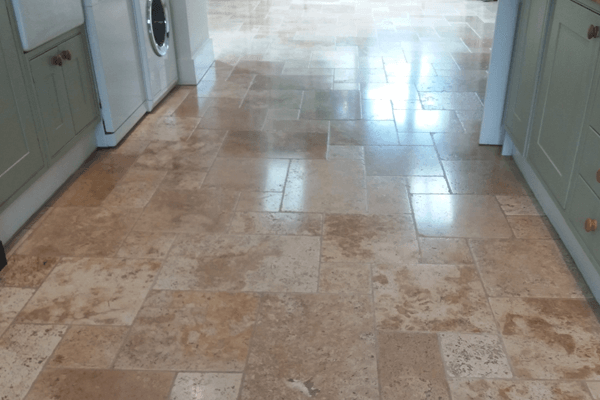Travertine floors look prettier and more elegant, a perfect addition in the interior and outdoors. In several ways, this is the same as limestone pavement in that it can be quite porous and therefore needs to be sealed to prevent surface damage.
Since travertine flooring is made of stone, you have to know how to deep clean travertine floors to keep its surface new throughout its life.
Regular management is essential for keeping the travertine clean. Use a broom, water, travertine floor mop, and rag to clean floors and avoid damage and scratches. Disinfecting the floors is relatively easy using a mild mixture of water and dish soap.
Then thoroughly clean the floors monthly with pH-neutral solutions for travertine. The attack would be debilitating, so you won’t have to fight with persistent spots. Finally, clean the grout lines with the paste. Explore more at the end of this article.

Contents
What is Travertine Flooring?
Travertine stone is found naturally, just like granite in the kitchen or marble in the bathroom. Still, travertine just grows around certain mineral deposits, furnishing this bizarre limestone with a unique and impressive appearance.
Often used for both floors and tiles, travertine is available within four main textures or styles:
- Honed: Sharp or honed travertine sits halfway between glossy and matte finishes, forming a balanced and slightly polished outlook.
- Tumbled: This kind of travertine looks old-fashioned and rustic, revealing a stylish entrance to the antique world.
- Polished: Clean and lustrous, polished travertine can be a sophisticated and vibrant style.
- Brushed: Matt travertine has some anti-reflective finish, thanks to the metal brushing. Travertine is a timeless yet modern addition to your home or residence with a wide array of texture styles, a mild oil color palette from rusty to beige. Also, it has a durable structure that can confront even heavy loads.
How Often Should You Clean The Travertine Floors?
Travertine floors should be wiped or mopped regularly and brushed weekly. A regular mop ensures that no dirt or dust gets into the holes. Make sure you use a dry mop, not a wet one. If something spills on your floor, clean it up immediately.
It is best to disinfect the floors once a month thoroughly. This way, you can be sure that your pores are free of germs or bacteria.
Also, keep in mind that when washing; keep your eyes on the grout lines. You should clean them in a few months’ break, based on your floor’s use and how filthy it is. If you are not in a busy space, you may be lucky and need to clean the grout less often.
Contemplate these general ground rules for travertine floors and apply them over both polished and honed stones.
Things to Consider Before Cleaning Travertine Floor
Travertine can be a burdensome stone, but it is also quite sensitive due to its tiny pores. Before you mop the floor, consider the following things:
Choose the right product:
When cleaning natural stones, you must take care of chemicals. Travertine tiles will absorb liquids and chemicals that subsequently discolor, tarnish or crack the tile. Hence, pick an item primarily formed for travertine, like RMR-86 Instant Mold and Mildew Stain Remover Spray.
Don’t Use Dish Soap Regularly:
Like chemical cleaners, dish soap is not much harsh. Still, you have to avoid this. But if you want, you can go with it four to five times a year to mop your floors.
PH neutral:
A pH-neutral cleaner is ideal for natural stones. It means that the item is not alkaline or acidic. Also, they should not be hard or abrasive as well as safer to work.
Avoid citrus or vinegar:
Never use vinegar on travertine floors or citrus fruits like lemons. The acid may soften the surface.
Always try your solution:
Before you start, do a little testing in a discreet place to ensure the item is safe.
Do not apply harsh chemicals:
You should keep chemicals like ammonia and bleach away from travertine floors. It can quickly create damage, erosion, and even aging of floors.
Avoid soaked mop:
Tighten the mop as hard as possible until it becomes damp. A wet mop can create water seepage, which may cause damage.
How to deep clean travertine floors
When clean your travertine floor, you need to follow some branches of steps. Here we go.
Step 1: Arrange all the essentials
When choosing a travertine floor cleaner, remember that your floor can tolerate a pH around seven or below or a neutral pH. Acids such as lemon, vinegar, or other stubborn chemicals such as bleach can respond poorly to the stone. Again, it may cause blemishes and permanent impairment.
Natural travertine floors have many pores, making them brittle and quickly destroying the stone. Use a travertine stone filling yearly to prevent the absorption of particles and liquids. There are two types of sealants available:
• Surface sealant
• Penetration sealant
Let’s have a look at the tools and materials at a glance!
Tools:
• Vacuum cleaner or broom
• A bucket for floor washing
• Sponge or mop
• Towels
• Narrow, small brush for exfoliating seams
Materials:
• One tablespoon non-acidic, mild dishwashing liquid
• Hot water
• Bicarbonate of soda
• Stone cleaner
Arrange all the tools and materials before going to the further steps.
Step 2: Vacuum or wipe the floor
After arranging all the essential tools and materials, sweep the travertine floor to remove fine particles of sand and dirt. A hard floor vacuum works excellent, combined with a broom to pick up larger debris.
Step 3: Mop your floor
Use a little warm water over the floor by a mop or a nearly squeezed mop to keep the travertine floor slightly damp. Avoid saturating the travertine surface with water.
That’s because it may soak outside the seal or in grout lines. And it may cause degradation, discoloration, and the growth of mildew and mold.
Step 4: Disinfect your floor
If you have pets roaming around frequently, you might like to disinfect your floors every so often. You can usually do it with a chemical such as bleach or natural products such as vinegar.
When sanitizing the floor, add a non-acidic, mild dish soap tablespoon to one gallon water. Wipe the floor with a damp mop with the solution. Wipe with fresh water for the second time to remove any residue. Also, dry the surface with a towel.
Step 4: Grout lines cleaning
Grout cleaning around the travertine tiles may be difficult as you don’t need to damage the stone. Yet you will need something harsh for grout cleaning.
If grout lines need cleaning, it is better to mix water and baking soda to form a grated paste. Gently rub this lightly abrasive paste into the grout lines with a small brush to avoid scraping or scratching the tile’s edge with the instrument. Additionally, try an especially formulated stone cleanser to test and clean your grout.
Final Verdict:
Travertine belongs to the same group as limestone, cream ivory, and marble. Each has different durability and hardness for the heat and pressure applied during casting into the ground. So, you have to consider some of its inherent vulnerabilities while cleaning and maintaining these materials.
However, it includes regular long-term maintenance and special precautions and instruction to be followed when working on these surfaces. And, I hope, our “how to deep clean travertine floors” guide has made all the things clear to you.
